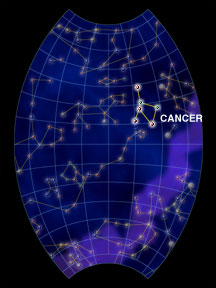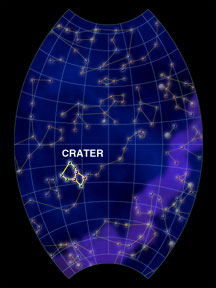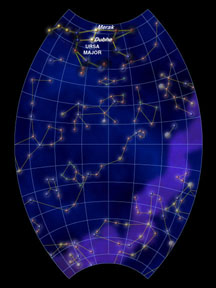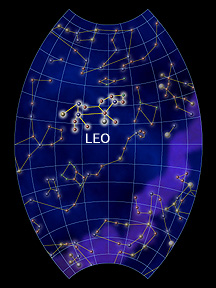The Constellation Leo, the lion
Click on image for full size
Leo
The constellation Leo is known as the Lion. Leo's head and mane make up an upside-down question mark called the Sickle. One of the brightest spring stars,
Regulus (Latin for
"little king"), is at the base of the question mark. The rest of
Leo's body, legs, and tail extend to the east.
During the dry season in ancient Egypt, the lions of the desert came
close to the valley of the Nile when the river flooded, which used to
happen when the Sun was in Leo. Some have interpreted this as the
origin of the name of the constellation. The ancient Sumerians,
Babylonians, Persians, Syrians, Greeks, and Romans, all recognized
this constellation as a lion.
Leo is visible from February through June. Cancer sets to the east and Virgo is to the west. Hydra and Crater are below.
You might also be interested in:

How did life evolve on Earth? The answer to this question can help us understand our past and prepare for our future. Although evolution provides credible and reliable answers, polls show that many people turn away from science, seeking other explanations with which they are more comfortable.
...more
Cancer, the Crab, is a member of the Zodiac, a group of constellations that the Sun travels through each year. Cancer is best seen during the month of March, but is visible from December through June.
...more
The constellation Virgo is known as The Maiden. The constellation represents almost every famous and powerful female in mythology, including Athena, Artemis, Persephone and Demeter. She is usually carrying
...more
Hydra is the longest constellation in the sky and is also the largest in terms of area. It is so long that it takes more than six hours to rise completely. Along its northern side, we can observe the zodiacal
...more
The constellation Crater is known as the Cup. Crater is a small constellation located between Hydra and Leo and next to Corvus. Crater is best seen sometime between March and June. You'll have to scan
...more
Something new and exciting is happening at Windows to the Universe! Windows scientists say they discovered twelve new stars, including one that is the second brightest in the night sky! They decided to
...more
The Leonids meteor shower is expected to reach its peak intensity during this year and next year on November 17/18th. The best show will be seen this year in Asia and next year in Europe and Asia. During
...more
Hercules, the great Greek warrior, can be seen kneeling in the sky for northern latitudes throughout the Spring months. Hercules first becomes visible in the east in April, and works his way high across
...more














